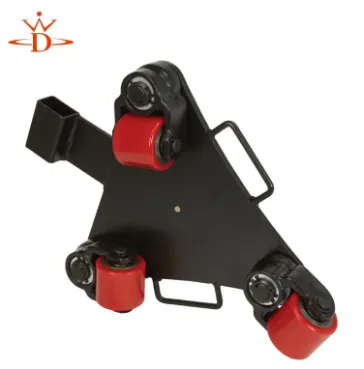Master the Move: Discover the Power Behind a Professional Machinery Mover
Relocating industrial equipment is not a task for the unprepared. Whether it's assembling a new production line or shifting legacy machines in tight spaces, precision and safety are vital. That’s where a dependable machinery mover comes in. Designed to move loads of all sizes and shapes, these tools are the backbone of safe and efficient industrial handling. If you're in the market for industrial mobility solutions, it's time to understand exactly what a machinery mover can do—and why the right choice will save you time, money, and risk.

What is a Machinery Mover and Why Does It Matter?
A machinery mover is a specialized material handling tool designed to lift and transport heavy or sensitive equipment with control and stability. Unlike forklifts or cranes, a machinery mover offers a low-profile, floor-level method of shifting loads without disturbing surrounding infrastructure. The system minimizes vibrations and load swaying, providing excellent safety during internal moves.
Often used during factory relocation, large-scale assembly, and equipment repairs, a high-quality machinery mover system typically works alongside heavy equipment skates and cargo trolley components. These tools work together to distribute weight evenly, reduce rolling resistance, and enable easy positioning—even in restricted environments.
If your operation requires moving presses, turbines, transformers, or injection molding machines, a machinery mover setup is the investment that ensures every move is efficient and damage-free.
Types of Machinery Mover: Finding the Right Fit
There is no one-size-fits-all when it comes to machinery mover systems. Instead, there are multiple types, each engineered for different applications and capacities.
Manual movers are best for short, controlled moves where the operator guides the load by hand. These systems often rely on heavy duty machine dolly configurations, offering simplicity and control. They’re perfect for confined spaces or short-range tasks where visibility and maneuverability are key.
Hydraulic machinery mover units are built for lifting. These combine jacks with rollers or cargo trolley systems, enabling users to raise heavy equipment from the base and roll it into place. Ideal for irregular or uneven surfaces, they deliver brute strength and rugged reliability.
Electric machinery mover systems elevate performance by integrating motorized traction, smart load sensors, and remote control navigation. Designed for large facilities and repetitive movement tasks, these are most often paired with heavy equipment skates for enhanced floor contact and load dispersion.
We offer all of these types in our product line—including full kits with cargo trolley for sale, ready to ship worldwide.
Heavy vs. Light Machinery Mover: What's the Difference?
Choosing between a heavy and light machinery mover is all about understanding your load profile. A heavy machinery mover is built to carry loads upwards of 10 tons, typically incorporating steel frames, multi-wheel designs, and reinforced load pads. These models are often accompanied by high-capacity heavy duty machine dolly components or modular cargo trolley systems for full support.
In contrast, a light machinery mover might be rated for loads under 5 tons. These are easier to operate manually and ideal for routine maintenance, smaller equipment shifts, or tight space jobs. Lightweight movers often work with smaller heavy equipment skates, providing agility without compromising on durability.
The key difference lies in structural strength, load capacity, and operational complexity. Heavy-duty models are for critical moves with no room for error. Lighter units offer speed and flexibility. No matter which category fits your needs, our experts ensure you get the right machinery mover with matching accessories.
Cargo Trolley and Heavy Equipment Skates: The Unsung Heroes
While the machinery mover often takes the spotlight, it wouldn’t function effectively without the essential support of cargo trolley systems and heavy equipment skates. These components reduce ground friction and bear the brunt of the load, distributing it safely across floors without damage.
Our cargo trolley systems feature 360-degree rotation, non-slip plates, and nylon or steel rollers to suit your surface conditions. Each cargo trolley for sale is rated and tested for both dynamic and static load performance. For customers requiring maximum reliability, we offer skates with interchangeable rollers and reinforced axles for repeated use.
Heavy equipment skates come in various configurations—fixed, swivel, or steerable—allowing operators to move in straight lines or pivot tight corners. These units are especially useful when moving large industrial systems in constrained environments.
Buying just any cargo trolley for sale won’t deliver long-term value. Choose a system that integrates flawlessly with your machinery mover, built with durability, modularity, and real-world safety in mind.
Machinery Mover FAQs
What is the difference between a manual and hydraulic machinery mover?
Manual movers rely solely on operator input, while hydraulic versions use fluid-powered lifting for added control. Hydraulic movers are more suited for heavier or uneven loads.
How do I know if I need a light or heavy machinery mover?
If your machinery weighs under 5 tons and needs flexible handling, a light mover will suffice. For loads above 10 tons or high-stakes operations, opt for a heavy-duty machinery mover setup.
Can heavy equipment skates be reused across different machines?
Yes, quality heavy equipment skates are designed to be reused across various machines. Always check the load rating and condition before reuse.
What are the advantages of buying a full cargo trolley for sale kit instead of separate parts?
A full kit ensures all components are compatible in terms of load capacity, roller type, and structural design. It saves time and improves safety during setup.
Are there certifications for machinery mover systems?
Yes, our machinery mover products comply with CE and ISO standards. All cargo trolley and dolly components are tested under international load safety regulations.
-
Dawei Hand Pallet Truck 1200mm, 2000–5000 KGS Heavy-DutyNyheterNov.17,2025
-
Dawei Hand Pallet Truck, Fork Length 1200mm, 2000–5000kgNyheterNov.17,2025
-
Large Equipment Movers – Safe, Insured & On-Time ServiceNyheterNov.17,2025
-
Machine Moving Dollies | Heavy-Duty, Low-Profile, SafeNyheterNov.17,2025
-
Permanent Lifting Magnet - Heavy-Duty, Safe, Quick ReleaseNyheterNov.11,2025
-
PML 1000 Lifting Magnet - Heavy-Duty, Safe, No PowerNyheterNov.11,2025
-
Large Equipment Movers: Safe, Fast, Certified ProsNyheterNov.11,2025
